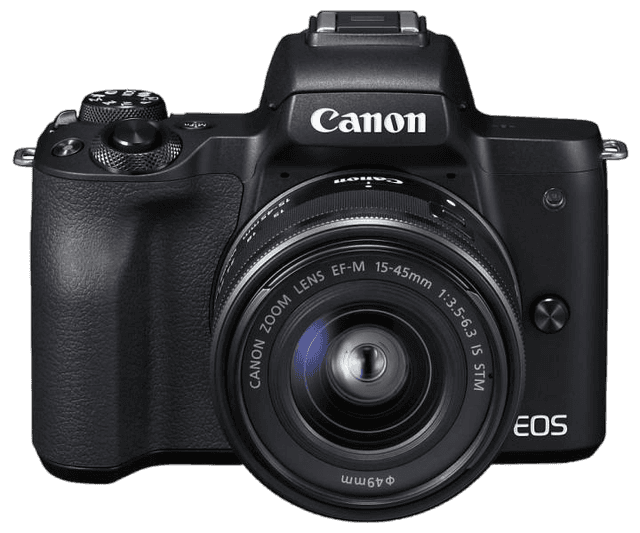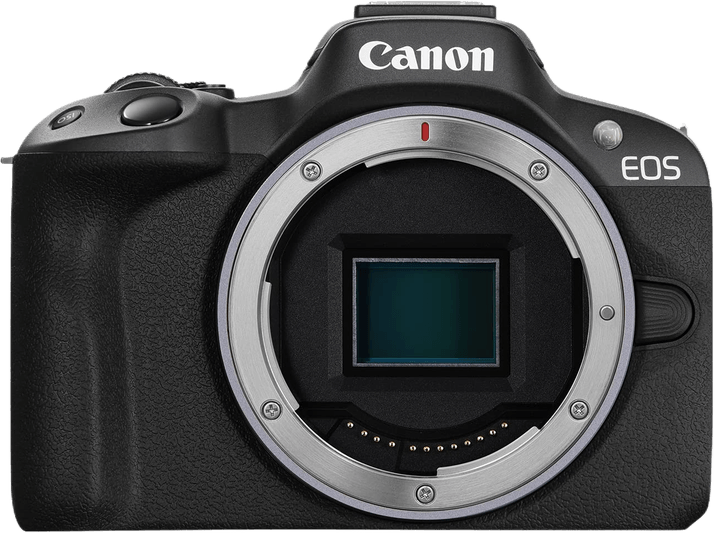Canon EOS M50 vs EOS R50 Comparison
Canon EOS M50

Canon EOS R50

The Canon EOS R50 outperforms the Canon EOS M50 with a score of 70/100 compared to the M50’s 59/100. Both cameras share the same mirrorless camera type and have a similar size, with the R50 being slightly slimmer at 116 x 86 x 69mm compared to the M50’s 116 x 88 x 59mm. The R50 is also a bit lighter, weighing 375g while the M50 weighs 390g.
The R50 has a lower launch price of $679, making it more affordable than the M50, which launched at $779. The R50’s higher score highlights its better performance and features, making it a more attractive option for photographers. The M50, however, was released in 2018, which may appeal to those who prefer an older, tried-and-tested model.
Based on these specifications, the Canon EOS R50 is the better choice due to its higher score, lower price, and lighter weight, while the EOS M50 may still be suitable for those who prefer an older model.
Canon EOS M50 vs EOS R50 Overview and Optics
The Canon EOS R50 outperforms the Canon EOS M50 in optics with a score of 73/100 compared to the M50’s 59/100. Both cameras share several specifications, such as having 24 megapixels, a CMOS sensor, APS-C sensor size, and no image stabilisation. Despite these similarities, the R50 surpasses the M50 in certain aspects.
One notable advantage of the R50 is its faster shooting speed of 12 frames per second, compared to the M50’s 10 frames per second. This enables the R50 to capture action and fast-moving subjects more effectively. Additionally, the R50 features a more advanced Digic X processor, which contributes to improved image processing and overall performance.
The R50 also boasts a significantly higher DXOMARK sensor score of 94, compared to the M50’s 58. This reflects the R50’s superior image quality, dynamic range, and low-light performance. Furthermore, the R50 uses the Canon RF lens mount, which offers access to a wider range of high-quality lenses, while the M50 uses the Canon EF-M lens mount, which has a more limited selection.
On the other hand, the M50 does not have any specific advantages over the R50 in terms of optics. The R50’s superior performance in shooting speed, processor, DXOMARK sensor score, and lens mount make it the clear winner in this comparison.
Considering the optical performance and specifications, the Canon EOS R50 is evidently a better choice for photographers seeking higher quality images and faster performance. The M50, while still a capable camera, falls short in comparison to the R50’s superior optics and features.
Canon EOS M50 vs EOS R50 Video Performance
The Canon EOS M50 and Canon EOS R50 both have a video score of 91/100, making them equal in terms of video capabilities. Both cameras have a maximum video resolution of 4K and dimensions of 3840 x 2160. Additionally, they both offer a maximum video frame rate of 120fps and have built-in time-lapse functionality.
Despite having the same video scores, there are certain aspects in which one camera excels over the other. The Canon EOS M50 stands out with its compact and lightweight design, making it a more portable option for videographers on the go. This advantage allows users to easily carry and maneuver the camera during video shoots, providing convenience and flexibility.
On the other hand, the Canon EOS R50 has a more robust build and is designed for professional use. This camera offers better ergonomics and improved handling, making it ideal for those who require a reliable and sturdy camera for their video projects. Additionally, the EOS R50 is part of Canon’s full-frame mirrorless lineup, which means it has a larger sensor, resulting in better low-light performance and increased dynamic range.
In the end, the choice between the Canon EOS M50 and the Canon EOS R50 depends on the user’s preferences and requirements. The M50 is the better choice for those who prioritize portability and ease of use, while the R50 caters to professionals seeking a robust and reliable camera for their video projects. Both cameras offer excellent video capabilities, and users can expect high-quality results regardless of their choice.
Canon EOS M50 vs EOS R50 Features and Benefits
The Canon EOS R50 emerges as the winner in this comparison with a feature score of 72/100, slightly edging out the Canon EOS M50 which has a score of 70/100. Both cameras share several key specifications, including a 3-inch screen size, touchscreen functionality, flip screen, GPS absence, WIFI, and Bluetooth connectivity.
The EOS R50 holds an advantage over the M50 with its higher screen resolution of 1,620,000 dots compared to the M50’s 1,040,000 dots. This higher resolution provides clearer and more detailed image previews and menu navigation, enhancing the overall user experience.
Despite the R50’s superiority in screen resolution, the EOS M50 does not fall far behind in terms of features. Both cameras offer user-friendly touchscreen interfaces, flip screens for versatile shooting angles, and seamless wireless connectivity options. These shared features make both cameras suitable for a variety of photography styles and situations.
While the EOS R50 takes the lead in this comparison, the EOS M50 still holds its ground as a competitive option. The two-point difference in feature scores indicates that the M50 remains a viable choice for those seeking a balance of performance and value. Both cameras offer a solid set of features that cater to the needs of photographers and content creators alike.
In the end, the Canon EOS R50 takes the win due to its higher screen resolution, but the EOS M50 remains a strong contender in the market. Ultimately, the choice between these two cameras will depend on individual preferences and priorities, as both offer a range of useful features.
Canon EOS M50 vs EOS R50 Storage and Battery
The Canon EOS R50 outperforms the Canon EOS M50 in storage and battery, scoring 35 points compared to the M50’s 13 points. Both cameras have one memory card slot and accept SD, SDHC, and SDXC cards. However, the R50 is compatible with both UHS-I and II cards, while the M50 only supports UHS-I.
The R50 has a longer battery life, offering 370 shots per charge, compared to the M50’s 235 shots. The R50 uses an LP-E17 battery, whereas the M50 relies on an LP-E12 battery. Additionally, the R50 supports USB charging, making it more convenient for on-the-go use.
The M50 does not excel in any storage or battery aspect compared to the R50. The R50’s advantages in memory card compatibility, battery life, and USB charging make it the superior choice for photographers needing longer shooting sessions and more storage options.
Considering these points, the Canon EOS R50 is the better choice for storage and battery capabilities, providing better performance and flexibility for users.
Canon EOS M50 vs EOS R50 Alternatives
Are you considering buying or upgrading from a Canon EOS R50 or a Canon M50? Our camera comparison tool can help you weigh up its price and performance against the competition.
Here are some related popular camera comparisons to check for inspiration:

